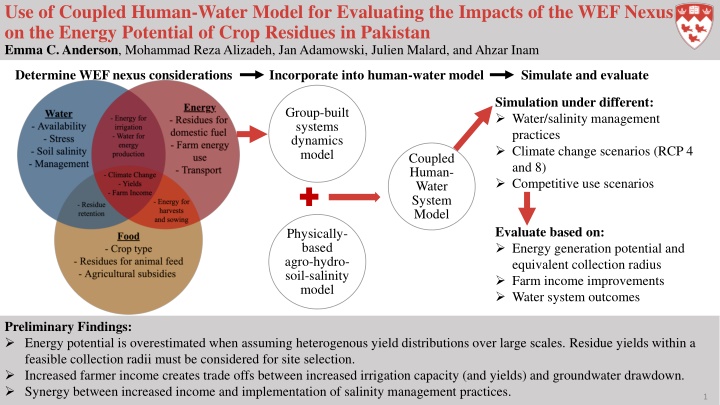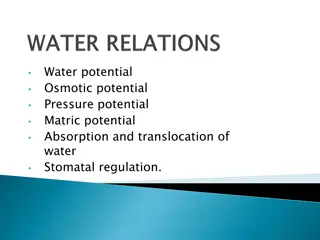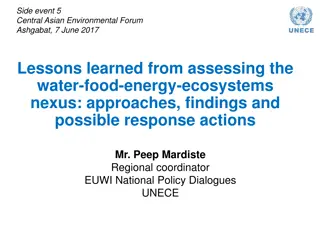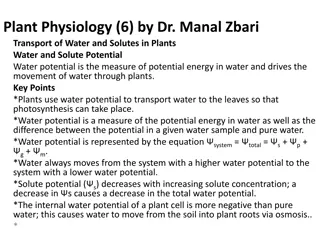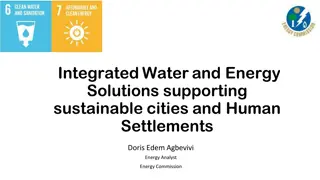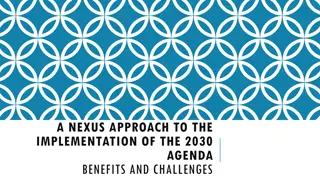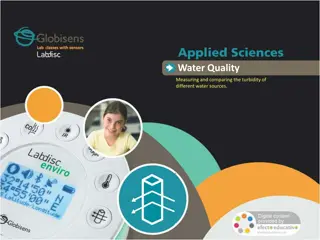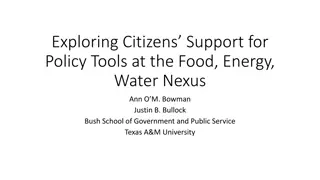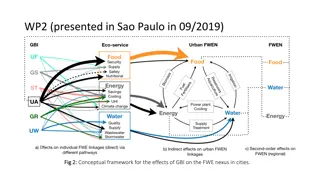Evaluating Human-Water Model for WEF Nexus Impact on Energy Potential in Pakistan
Coupled Human-Water Model assesses WEF Nexus impacts on crop residue energy potential in Pakistan under various scenarios. Preliminary findings highlight key considerations for sustainable energy generation and agricultural income improvements.
Download Presentation

Please find below an Image/Link to download the presentation.
The content on the website is provided AS IS for your information and personal use only. It may not be sold, licensed, or shared on other websites without obtaining consent from the author.If you encounter any issues during the download, it is possible that the publisher has removed the file from their server.
You are allowed to download the files provided on this website for personal or commercial use, subject to the condition that they are used lawfully. All files are the property of their respective owners.
The content on the website is provided AS IS for your information and personal use only. It may not be sold, licensed, or shared on other websites without obtaining consent from the author.
E N D
Presentation Transcript
Use of Coupled Human-Water Model for Evaluating the Impacts of the WEF Nexus on the Energy Potential of Crop Residues in Pakistan Emma C. Anderson, Mohammad Reza Alizadeh, Jan Adamowski, Julien Malard, and Ahzar Inam Determine WEF nexus considerations Incorporate into human-water model Simulate and evaluate Simulation under different: Water/salinity management practices Climate change scenarios (RCP 4 and 8) Competitive use scenarios Group-built systems dynamics model Coupled Human- Water System Model Evaluate based on: Energy generation potential and equivalent collection radius Farm income improvements Water system outcomes Physically- based agro-hydro- soil-salinity model Preliminary Findings: Energy potential is overestimated when assuming heterogenous yield distributions over large scales. Residue yields within a feasible collection radii must be considered for site selection. Increased farmer income creates trade offs between increased irrigation capacity (and yields) and groundwater drawdown. Synergy between increased income and implementation of salinity management practices. 1
The problem Pakistan is an energy-poor country. The current power infrastructure is poorly managed and underdeveloped. Average energy deficits are around 3,000 MW (Irfan et al., 2020). Persistent energy shortfalls leads to load-shedding of 7-10 h and 15-20 h per day in urban and rural areas, respectively. Unreliable electrical supply creates a barrier to economic growth and development. Pakistan is reliant on fossil fuels. Over 65% of energy produced in Pakistan comes from fossil fuel-based thermal energy plants (Rauf et al., 2015), with around 5% from renewable sources. Most fossil fuels are imported (Kashif et al., 2017). Pakistan wants to increase energy production with indigenous resources, including renewables. The government is committed to both mitigation and adaptation to Climate change (with respect to their Common but Differentiated Responsibility and Respective Capabilities (CDR-RC)). Pakistan will continue to exploit fossil fuels to deal with the energy crisis but simultaneously want to increase the share of renewables in their energy portfolio. 2 EGU General Assembly 2021
A solution: energy from crop residues Corn Stover Cotton Straw Rice Husk Wheat Straw Bagasse Recent studies have suggested that common agricultural residues in Pakistan (shown above) may be a viable alternative renewable energy source through direct-fired and co-fired plants. Potential benefits of agriculture-residue-based energy production: Does not compete with food production for land and water. Less CO2 emissions than conventional thermal-based power plants. Lower capital costs (compared to biogas and other renewables in the region). Technical capacity is already in place. Can reduce open-field residue burning. Can supplement farmer income through residue sales. EGU General Assembly 2021 3
Current Estimates of Crop Residue Energy Potential Residue yield = grain yield * residue to grain ratio * residue recovery factor (RRF) * surplus availability factor (SAF) Energy potential per area= Residue yield * Residue lower heating value/cropped Area Number of power plants = energy potential per area/collection radius (Cr) Residue Recovery factor (RRF) refers to harvest efficiency for residues. Surplus availability factor (RRF) is the recovered residues minus competitive uses. Collection Radius (Cr) is the feasible transport radius from farm to power plant. Source Annual Energy Potential Across Pakistan from Crop Resiudes Yield Data Scale Values Khasif et al. (2020) 11,000 MW Administrative Division RRF = 50%, SAF= n.a., Cr = 50 km Uzair et al. (2020) Administrative Division RRF = 0.35-1, SAF= 0.2-1, Cr= n.a. 10,331 MW assuming SAF=1 3100 MW considering competitive uses Farooq et al. (2013) Country RRF=0.35, SAF= n.a., Cr= n.a. 1,744 MW technical potential * Does not consider bagasse or wheat due to competitive uses Iqbal et al. (2017) 58,313 MW Country RRF= n.a., SAF= n.a., Cr = n.a. Irfan et al. (2020) 90,223 MW Country RRF= n.a. SAF=n.a., Cr = n.a. EGU General Assembly 2021 4
Limitations to Current Estimates Yield data scale Punjab province Scale Faisalabad division Maximum collection radius Reasonable collection radius Too coarse of a scale does not consider sub-regional yield heterogeneity. A maximum viable equivalent collection radius of 50 km applies to Europe (Monfroti et al., 2015) and may be overestimated for Pakistan as the road network is less developed. Water-Energy-Food Nexus Considerations Crop (and residue) yields are impacted by a variety of factors related to Water-Energy-Food Nexus. 26% of irrigated land in Pakistan is salt-affected (Iman et al., 2017). Many regions of Pakistan operate under deficit irrigation. Residue yields can be impacted by management practices that aim to remediate soil salinity or fertility or reduce water usage in the short long term. Policies to increase resource efficiency may decrease available residues . Climate Change and Forecasts Climate change will impact water availability and temperature, potentially increasing water and heat stress, which may not be adequately captured with statistical forecasting techniques. EGU General Assembly 2021 5
My Research To address these caveats, my research provides a case study in the Rechna Doab, Pakistan. Objectives: 1. Study the implications of the WEF nexus on crop-residue based biomass energy production in Pakistan 2. Evaluate the viability of energy production with crop-residues in both salt-affected and non-salt affected lands under two uncertain conditions: a) different climate change scenarios b) different water/soil salinity management practices 3. Understand the potential socio-economic implications of crop-residue-based energy production on small-holder farmers in Pakistan Study Area: The modelled area is an agricultural region bound by the Chenab and Ravi rivers and the Haveli canal. The area is within the Faisalabad administrative district of Punjab, an area with a high potential for residue- based energy (Khasif et al., 2020; Uzair et al., 2020). The area includes both salt and non-salt affected soils. 6 EGU General Assembly 2021
Materials This research applies a Physically-based and Group (stakeholder) Built System Dynamics Model (P-GBSDM) (Inam et al., 2017a,b) of the agricultural system in the Rechna Doab, Pakistan. The Group-Built System Dynamics Model (GBSDM) captures the socioeconomic and managerial components of the agricultural system. The Physically-Based Model (SAHYSMOD) simulates the hydrological parameters of the agricultural system. This modelling technique is appropriate as it allows for the portrayal and analysis of complex human- environmental feedbacks related to the WEF nexus. System dynamics model modules and their feedbacks (Inam et al., 2017b) EGU General Assembly 2021 7
Method Determine local WEF nexus considerations: Competitive residue use WEF feedbacks Amend the P-GBSDM to: Estimate residue yield Include feedbacks related to farmer income, costs (diesel use and harvest time) and electrical supply. WEF feedbacks Simulate the P-GBSDM from 2005-2035: Under different climate change scenarios Under different stakeholder-approved water management scenarios Under different crop rotations Evaluate impacts: Farmer Income and Profit Residue yield (over study area and in saline and non-saline fields) Equivalent collection Area Water system outcomes 8
Preliminary Results: WEF considerations and Feedbacks Food Energy Water EGU General Assembly 2021 9
Preliminary Results Current estimates overestimate energy potential by assuming heterogenous distribution of yields over large scales. Soil salinity and water stress threaten long-term yields and residue potential Yields within feasible collection radii must be considered for power plant site selection. Increased farmer income has implications: Trade-offs: Farmer irrigation from tubewells is limited by farm income. When income increases, farmers can afford to irrigate their crops more frequently, leading to less water stress and higher yields. However, more tubewell pumping leads to greater groundwater drawdown, which over time can decrease water availability and quality. Synergies: Farmers can only contribute a portion of income to water and salinity management practices. By increasing income, these practices can be implemented more quickly. Full results and policy implications are pending. EGU General Assembly 2021 10
References Abdullah, A., et al. Potential for Sustainable Utilisation of Agricultural Residues for Bioenergy Production in Pakistan: An Overview. Journal of Cleaner Production, Elsevier BV, Mar. 2021, p. 125047. Crossref, doi:10.1016/j.jclepro.2020.125047. Farooq, M. K., & Kumar, S. An assessment of renewable energy potential for electricity generation in Pakistan. Renewable and Sustainable Energy Reviews, Pergamon, 20, 2013, pp. 240-254. Crossref, https://doi.org/10.1016/j.rser.2012.09.042 Inam, A., et al. Coupling of a Distributed Stakeholder-Built System Dynamics Socio-Economic Model with SAHYSMOD for Sustainable Soil Salinity Management. Part 2: Model Coupling and Application. Journal of Hydrology, Elsevier BV, Aug. 2017a, pp. 278 99. Crossref, doi:10.1016/j.jhydrol.2017.03.040. Inam, A., et al. Parameter Estimation and Uncertainty Analysis of the Spatial Agro Hydro Salinity Model (SAHYSMOD) in the Semi-Arid Climate of Rechna Doab, Pakistan. Environmental Modelling & Software, Elsevier BV, Aug. 2017b, pp. 186 211. Crossref, doi:10.1016/j.envsoft.2017.04.002. Irfan, M., et al. Assessing the Energy Dynamics of Pakistan: Prospects of Biomass Energy. Energy Reports, Elsevier BV, Nov. 2020, pp. 80 93. Crossref, doi:10.1016/j.egyr.2019.11.161. Kashif, M., et al. Untapped Renewable Energy Potential of Crop Residues in Pakistan: Challenges and Future Directions. Journal of Environmental Management, Elsevier BV, Feb. 2020, p. 109924. Crossref, doi:10.1016/j.jenvman.2019.109924. Monforti, F., et al. Optimal Energy Use of Agricultural Crop Residues Preserving Soil Organic Carbon Stocks in Europe. Renewable and Sustainable Energy Reviews, Elsevier BV, Apr. 2015, pp. 519 29. Crossref, doi:10.1016/j.rser.2014.12.033. Rauf, O., et al. An Overview of Energy Status and Development in Pakistan. Renewable and Sustainable Energy Reviews, Elsevier BV, Aug. 2015, pp. 892 931. Crossref, doi:10.1016/j.rser.2015.04.012. Uzair, M., Sohail, et al. Agricultural residue as an alternate energy source: A case study of Punjab province, Pakistan. Renewable Energy, 162, 2020, pp. 2066 2074. Crossref , https://doi.org/10.1016/j.renene.2020.10.041 11
